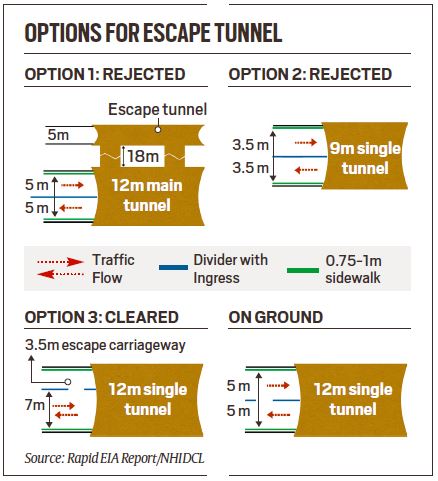Weighing options for the “best-suited cross-section” of the tunnel, the EIA report also rejected — as “not recommended at all and ignored” — what resembles the layout described by Minister for Road Transport and Highways Nitin Gadkari in Rajya Sabha on December 6: A “separation wall” at the centre of the tunnel’s carriageway along with “egress openings” for “escape” during an emergency.

What was recommended instead was the original project plan: A dedicated 3.5m escape channel separated by a concrete barrier from a 7m carriageway meant for two-way traffic inside a D-shaped tunnel.
Story continues below this ad
But, as reported by The Indian Express, this design was later modified during the construction, apparently for better space utilisation and traffic safety.
“Instead of leaving an escape channel on the left, we put the divider in the middle of the tunnel for single-way traffic on either side. This created more space for traffic and eliminated the risk of head-on collisions,” a senior project engineer said.
A tunnelling expert involved in the rescue operation last month pointed out that a total blockage of the Silkyara tunnel made “the positioning of the divider” immaterial and only a separate evacuation tunnel could have helped.

“A situation like this (collapse) requires a separate evacuation duct running next to the main tunnel with access at regular intervals, or a few lateral inclined escape adits rising to the ground surface. Having an escape passage in the same tunnel helps during traffic or fire incidents, but not if there is a total blockage,” the expert said.
Story continues below this ad
The rapid EIA report considered only vehicular accidents under “Various Scenarios of Risks and Disaster”. It rejected the option of constructing “two parallel tunnels about 18m apart” apart and connected at suitable intervals.
“The construction time and cost required is more for two tunnels, two portals and two sets of ventilation systems. This system is best suited in case of heavy traffic volume but at current location, the traffic volume is only 2000 PCU. Hence this proposal is also not recommended,” it said — PCU stands for passenger car unit.
The 208-page rapid EIA report was submitted by the Ministry of Road Transport and Highways (MoRTH) to a Supreme Court panel in September 2020 when the Silkyara tunnel was “already under construction and more than 15% of the work has already been completed”.
“Since work was already on, the rapid EIA report reflected the project plan. For the rescue channel, too, it rejected the options not on the card. It could not have predicted that the project would go on to drop the escape channel altogether,” a consultant involved in the EIA process said.
Story continues below this ad
Sanjeev Sharma, Director (Technical) of Enviro Infra Solutions, the company that conducted the EIA, declined to comment.
Project developer National Highways & Infrastructure Development Corporation Ltd (NHIDCL), owned by the MoRTH, did not respond to requests for comments.
The Silkyara-Barkot tunnel is part of the 889-km Char Dham project which was broken down into “53 civil works” to avail the exemption from environmental clearance offered to all linear projects under 100 km since 2013. As a result, no segment of the mega highway project was required to conduct an EIA, otherwise mandatory under the Environment Act.
Challenged at the National Green Tribunal (NGT), the MoRTH maintained that the Char Dham road segments were separated by 16 bypasses. In September 2018, the NGT agreed and ruled that the project did not require statutory EIA.
Story continues below this ad
In October 2018, the Supreme Court put a stay on the NGT order. In August 2019, it formed a High Powered Committee (HPC) and asked it to give directions to the MoRTH for conducting an EIA of the Char Dham project. Since there was not enough time, said environmentalist Hemant Dhyani who served in the HPC, the MoRTH was asked to conduct a rapid EIA in October 2019.
In September 2020, months after the HPC submitted its report, the MoRTH forwarded 37 rapid EIA reports for each of the 37 segments of the Char Dham project under construction. One of these 37 rapid EIA reports rejected the twin-tunnel option and the layout the Silkyara tunnel eventually opted for.










